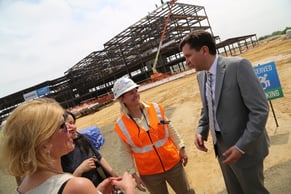I have been leading process change in organizations for more than 30 years. During that time, I have found that all too often, the focus of new initiatives is on the development or acquisition of new tools, adoption of new processes, deployment strategies, funding and evaluation of final rollouts. This reminds me of the often derided software development model of build-ship-test, where new features are added to already bloated applications, rollouts crash previous features that worked wonderfully, and then end users are left cleaning up the mess helping developers find the bugs in their products via a drawn out process of tech support calls, error log submissions; and finally, the release of patches. Proactive and thorough communication on the front end is missing, as is the follow-through on helping people understand what's going on when problems arise and how to resolve them in a timely, non-frustrating manner.
Within an organization or project, this brew of issues is a recipe for disaster. Staff or end users feel left out of a process, feelings get hurt and deployments end up under-utilized as people don't feel the buy-in necessary to participate. On architecture projects, poor communication on efforts to improve operations, optimize building efficiencies or enhance facility performance can result in increased costs, gaping errors in the final project delivery resulting in lawsuits and arbitrators, lost client confidence, and otherwise noteworthy projects being relegated to the heap of could-have-been efforts lamented for their lost opportunities.
 On a recent, large project at another firm, I watched with concern as the change management team hired directly by the program manager and client was let go after months of miscommunication. Insufficient communication about their project role, the timing of their onboarding, the marshaling of client staff for engagement in the process, and the integration of all the moving parts into the architectural timeline for designing and then documenting the project for construction all played a role. When the change managers were removed from the team, the project proceeded without the level of client-staff involvement and championing that could have helped the design team address a long list of concerns. Fortunately, everyone helped mitigate the fallout, and the project marches towards a beautiful and successful conclusion. Nonetheless, damage was done: other team members expended additional time and fee, the design process took longer than anticipated, construction schedules had to be adjusted, and the client's confidence was duly shaken – casting doubts on several key members who may or may not have had anything to do with the change management process.
On a recent, large project at another firm, I watched with concern as the change management team hired directly by the program manager and client was let go after months of miscommunication. Insufficient communication about their project role, the timing of their onboarding, the marshaling of client staff for engagement in the process, and the integration of all the moving parts into the architectural timeline for designing and then documenting the project for construction all played a role. When the change managers were removed from the team, the project proceeded without the level of client-staff involvement and championing that could have helped the design team address a long list of concerns. Fortunately, everyone helped mitigate the fallout, and the project marches towards a beautiful and successful conclusion. Nonetheless, damage was done: other team members expended additional time and fee, the design process took longer than anticipated, construction schedules had to be adjusted, and the client's confidence was duly shaken – casting doubts on several key members who may or may not have had anything to do with the change management process.
Adopt a communication-first mindset
A good-communication-first mindset can minimize the impact of inevitable snafus and rethinks that come with significant continuous improvement initiatives. Proactive communication involves listening first, understanding, confirming that understanding, thoughtfully considering implications and then voicing feedback in constructive ways intent on developing win-win solutions. Sometimes, the feedback is NOT what clients, customers or staff may want to hear, but it is critical to arriving at a mutual understanding and collaborative, negotiated solutions. When management closes their ears to consultants, staff or vendors, they short-circuit the opportunity to fully engage all members and develop active, vibrant teams working towards mutually beneficial goals and ultimate project success.
Think Win-Win
One habit Steve Covey details in 7 Habits of Highly Effective People is thinking Win-Win, not Win-Lose. For me, that translated into the idea of looking at every situation from the point of view of both my organizations’ best interests, as well as what is best for the clients or staff members with whom I interact. Working towards empathy drives insight into the solutions that can best bridge the gaps between the start of an initiative and the desired goal being pursued. An effective solution will achieve the desired results in a manner that is demonstrable and long-lasting.
Continuous improvement and change require this type of communication throughout an initiative's development process. Understanding an enterprise's weaknesses involves canvassing a large enough sampling of staff to understand the nexus of existing problems in order to focus on the goals that may bring the most significant impact in the shortest period. Throughout the development process, communication needs to be maintained continually, with core stakeholders able to solicit additional input and champion potential solutions. In this way, staff develop a greater sense of buy-in and a grass-roots championing culture can evolve organically. A sense of ownership in the process and results can give users and participants a greater sense of satisfaction with a product they are then more likely to adopt and evolve because they recognize it as a reflection of their input and efforts.
 In practice
In practice
On projects, this process comes into play from the initial team meetings all the way through design, documentation, construction and move-in. Engagement with end users, staff, volunteer personnel and management yields more successful project solutions that stand a much greater chance of long-term viability. Even in the age of ever-evolving technologies and shortened attention spans, properly planning for and integrating current needs and anticipated changes can make initial investments in architectural or systems upgrades, new facilities and long-term master plans better able to leverage current dollars into increased future returns.
For your future project, regardless of its scale, I suggest you assign the responsibility of maintaining proper communication throughout the project's development to an individual or team that understands the importance and methods of good communication. This entity can properly vet issues that arise throughout the entire process. Assigning this role to the most senior person on the team is not always a guarantee the communication will flow appropriately, as their time may be scattered across multiple responsibilities, and their day-to-day involvement in understanding a project’s flow may become compromised leading to miscommunication and misunderstood expectations. Forestall this possibility by making sure communication-first is a priority to the team as a whole and either led or championed by specific individuals able to meet the demands of the project.
At Array Architects, the individual assigned the prime communicator role is typically the engagement manager. This individual is tasked with keeping clients and project teams properly informed on all aspects of the project throughout its development timeline. Whether it’s the financial health of the project, the adherence to project goals and program, quality control of process or product, the engagement manager can help clients and teams better understand the health and progress of a project throughout its lifecycle. This leads to better and more successful projects, as expectations are better communicated, goals are more clearly understood and follow-through is better promoted and maintained across the team.
Discover other tips to improve your project by exploring our integrated approach to designing a Greenfield Hospital.


